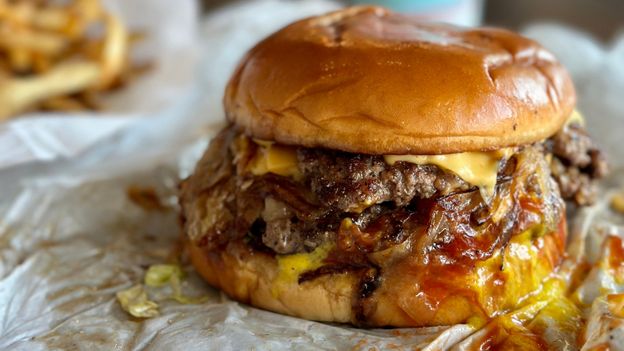In El Reno, a small industrial town just west of Oklahoma City on Oklahoma’s portion of Route 66, Sid’s Diner is hopping during lunch. With the sharp smell of crisping onions and burger grease in the air, most of the diners in the joint are munching down on a sandwich that was born out of poverty but made famous by love.
Adam, the second-generation owner at Sid’s Diner, taking over from his father Marty Hall, is working the flat iron grill. He presses the patty of beef mince made juicy with a mess of sweet onion slivers onto the searing heat. As meat cooks to a nice crispy crust, he flips the burger onion-side down, letting the grease and the grill cast the magic of caramelisation.
Marty figures he’s flipped five million burgers in his life. He’s made a living out of cooking the famous Oklahoma fried onion burger, a thin patty of beef filled with grilled, caramelised onion served on a flat-grill crispy bun. He’s even designed his own “onion burger spatula”, handmade from a masonry trowel.
He’s lost a wife because of flipping burgers but gained another one because of it. His own three children – Adam now taking the reins of the diner – were born into the smell of onion burgers and have diner blood running through their veins. And it’s all thanks to the Oklahoma fried onion burger, which rose from the scarcity of the Great Depression, thus earning the quaint nickname of the “Depression Burger”.
During America’s Great Depression in the 1930s, hamburger meat was expensive. In the small community of El Reno, a dreamer named Ross Davis and his father opened the Hamburger Inn, scoring a prime location along the brand-new famed Route 66 highway right as the economy shattered.
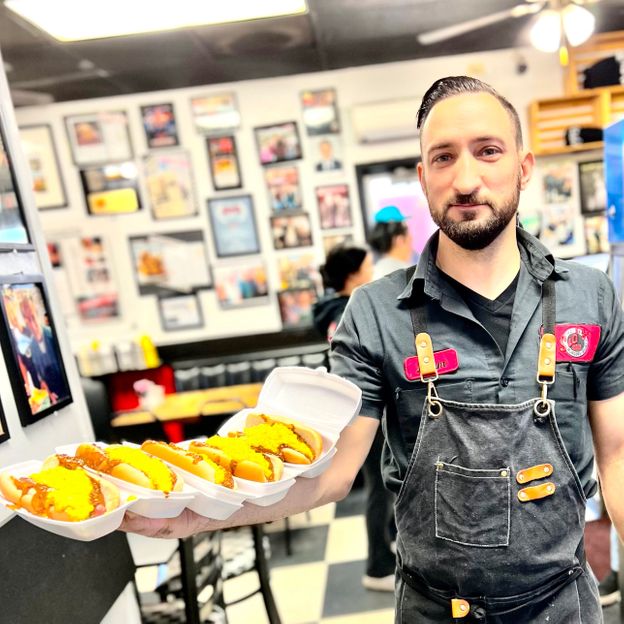
Adam Hall of Sid’s Diner continues the fried onion burger tradition made famous during the Great Depression (Courtesy of Adam Hall)
Savvy as only those who struggled during the economic crash of the Great Depression, Davis knew that while hamburger meat was expensive, onions were cheap. He fried up sliced onions and smashed them into meat patties with a spatula, using the onions to stretch that meat a little further. He called them “Depression Burgers”, and people loved them.
Today, people still flock to El Reno’s original fried onion burger joints like Sid’s, Johnnie’s Hamburgers and Coneys and Robert’s Grill for Depression Burgers. The burger is so beloved in the community that every first weekend in May, the El Reno Main Street Association closes off the streets for Fried Onion Burger Day , where an estimated 30,000 people flock to watch the fire department cook up an 850lb fried onion burger.
The rise of the Depression Burger
During the Great Depression of the 1930s, Oklahoma, like many other American states, was struggling.
Western Oklahoma and the far north-western corner of the state, known as the Panhandle, was blowing away in a desert that came to be known as the Dust Bowl. The land had become a sea of sand and wind due to improper farming practices, and commodities like beef were hard to come by.
“Everything was very expensive in Oklahoma during the Depression. But onions were cheap to grow,” said Larry O’Dell, director of communications and development at the Oklahoma Historical Society . “And once someone has a pretty good idea, people steal it. The fried onion burger spread across the state pretty fast, I assume.”
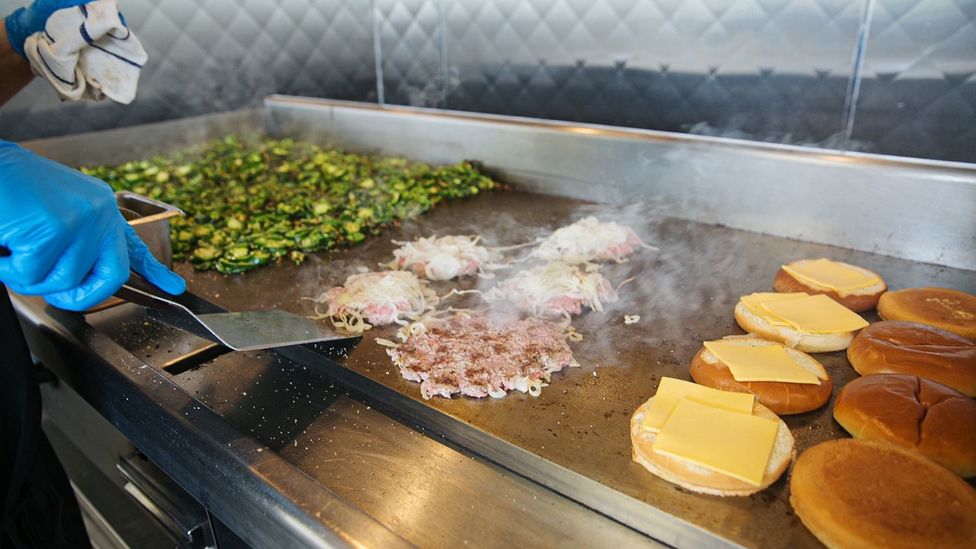
The burgers are covered in thin slices of onions and then flipped so the onions caramelise and cook into the beef (Credit: Choate House)
While Davis is credited for inventing the Depression Burger, the Route 66 specialty was embraced by the entire El Reno community. “This became what is El Reno’s local delicacy, and eventually, acquired taste spurred localised tradition,” said Shana Ford, executive director of El Reno’s Burger Day Festival . “When asking the community what we are known for, the answer is unanimous: fried onion burgers.”
El Reno started its Main Street programme in 1988 and the Burger Day Festival started soon after, becoming a state tradition that brings visitors from all corners of Oklahoma and beyond. The 850lb Big Burger consists of 350lb of beef, a 350lb homemade bun, 150lb of onions and lots of pickles and mustard, and everyone who attends is served a bite.
“We have a 12ft convection oven for the rising and baking of the bun, a 10ft circular grill for the burger that ‘flips’ and cooks the burger to perfection,” said Ford.
El Reno is where the fried onion burger originated. It’s been passed down from generation to generation, and we have perfected it to the best
Last year, The El Reno Main Street sold out of burgers for the first time in history, not counting the thousands of burgers cooked by Sid’s, Johnnie’s Hamburgers and Coneys and Roberts. “It’s an incredible weekend,” said Ford. “El Reno is where the fried onion burger originated. It’s been passed down from generation to generation, and we have perfected it to the best.”
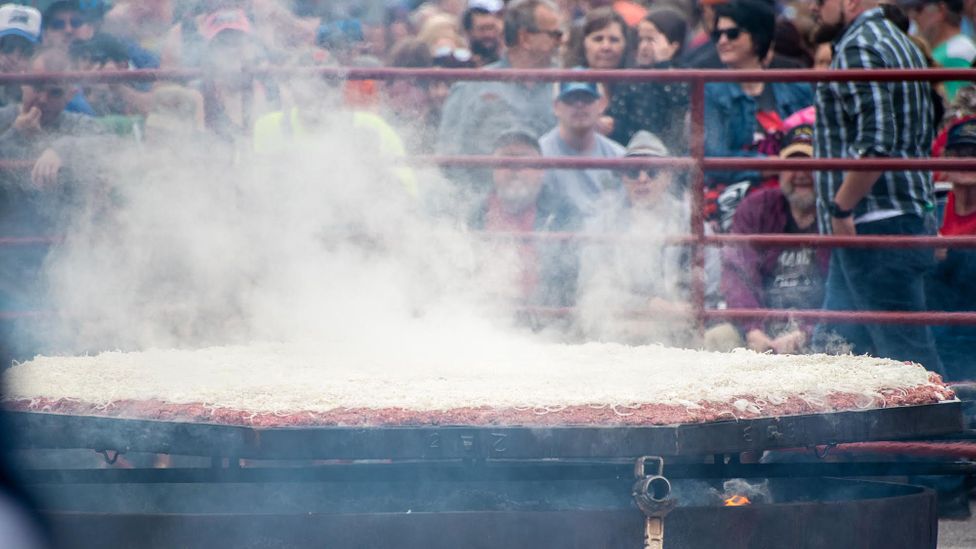
El Reno’s Fried Onion Burger Day festival features an 850lb onion burger and attracts upwards of 30,000 visitors each May (Credit: El Reno Main Street Association)
The perfect burger
Marty Hall started his burger empire at a young age. Born in El Reno, he got a job at age 13 washing dishes at a little burger place called Johnnie’s Hamburgers and Coneys. The first thing the owner Otis Bruce had him do was peel onions.
“I have never peeled so many onions in my life,” Marty said. “That’s where I learned to cook onion burgers.”
At age 19, he bought a restaurant just down the road called the Dairy Hut, where he cooked the famous El Reno fried onion burger along with fresh-cut fries and ice cream. He owned the Dairy Hut for 13 years, flipping burgers every day, before building Sid’s Diner (named after his father) on an abandoned corner in El Reno with the help of some friends in 1989.
“And it’s been booming ever since. It’s amazing,” Marty said.
These days, Marty and Adam will cook your fried onion burger with all the fixin’s or with any condiment you’d like. But, according to the Halls, the official way to eat the crispy burger is plain with a bit of mustard and a few pickle slices.
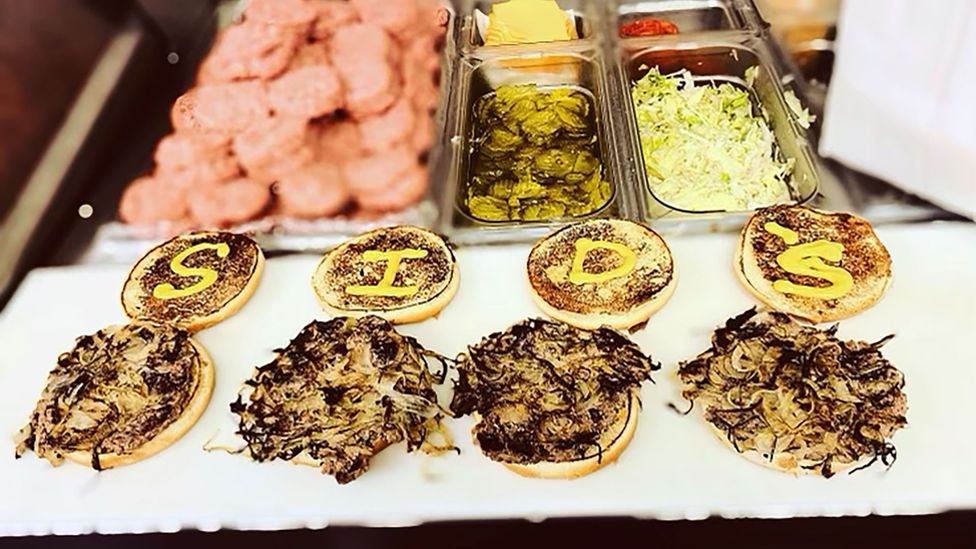
Sid’s Diner fried onion burgers are cooked to order, but the Halls say the best way to eat them is with a little mustard and pickle slices (Courtesy of Adam Hall)
Marty says that to make the perfect burger, “I use an 80/20 grind of fine ground beef and Spanish yellow onions sliced very, very thin. I use half and half salt and pepper. When we season the grill, we cover it with that pork salt [heavily salted slabs of pork belly] and we burn the pork salt there about 30 to 40 minutes.”
Local favourites
El Reno may have birthed the fried onion burger, but its tastiness couldn’t be contained by a small town. In Oklahoma’s capital of Oklahoma City, Tucker’s Onion Burgers is the relative newcomer. Owned by Keith and Heather Paul, Tucker’s opened its first of five locations on NW 23rd Street in Oklahoma City along the original Route 66.
It’s just like that era when families used to drive Route 66 and go out for a burger and shake. We wanted our own twist on that
“One of the things we love about the original Tucker’s location is that it is on Route 66 or ‘The Mother Road’. We have that 1950s nostalgic look in our restaurant,” said Heather. “It’s just like that era when families used to drive Route 66 and go out for a burger and shake. We wanted our own twist on that.”
Heather grew up in the shadow of the famed onion burger, and as a child in Oklahoma City, she walked to a greasy spoon diner called The Western Cafe.
“I have a little bit of an emotional tie to the fried onion burger, which I think probably everyone has an emotional tie to certain foods,” she said. “Tucker’s is unique because it’s not just regional. It is Oklahoma. And who doesn’t love burgers? Even if you’re not crazy about onions, it’s so yummy.”
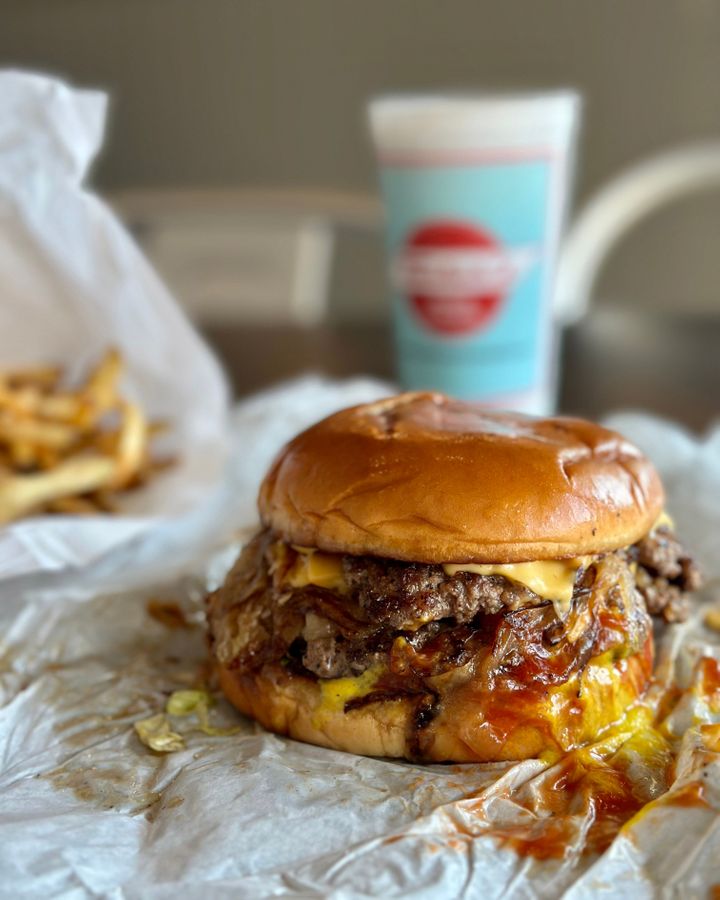
Tuckers serves up the double onion burger from its original location along Route 66 in Oklahoma City (Credit: Heide Brandes)
Other restaurants throughout the state tout their fried onion burger as well, and most locals have their go-to spot for the sandwich. Many swear by Johnnie’s Hamburgers and Coneys in El Reno, which is El Reno’s only female-owned restaurant. Lacey Brickey, who started working at Johnnie’s when she was 14 years old, later bought the place with her husband William.
“Johnnie’s opened in 1946, and we haven’t changed the recipe one bit, except adding more beef,” said Brickey. “We use a quarter pound of beef and measure out the onions by hand. We still get a lot of old timers who say it still tastes like the burgers they ate here 80 years ago.”
While Oklahoman in nature and created out of necessity, the crispy, caramelised onion specialty has been embraced in burger joints throughout the nation. High-brow culinary publications have even paid homage to the humble sandwich . But, for Oklahomans, the sandwich really is the taste of the state’s history and soul.
“We grew up on it. I grew up eating onion burgers. It’s delicious for starters, but whole generations have grown up eating it,” said O’Dell. “I don’t know how to explain it other than that it feels like Oklahoma. It tastes like home.”
BBC.com’s World’s Table “smashes the kitchen ceiling” by changing the way the world thinks about food, through the past, present and future.
—
Join more than three million BBC Travel fans by liking us on Facebook , or follow us on Twitter and Instagram .
If you liked this story, sign up for the weekly bbc.com features newsletter called “The Essential List”. A handpicked selection of stories from BBC Future, Culture, Worklife and Travel, delivered to your inbox every Friday.

